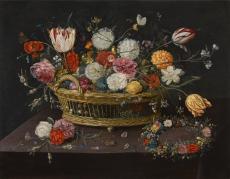


Only in recent decades has Philips de Marlier escaped from the oblivion into which he had fallen centuries ago. It is difficult to believe that only as recently as 1949 did Edith Greindl publish his first known work, a large panel on which a table full of food and drink is represented. This picture is dated 4 August 1634 and also carries the name of the artist: Philps de Marlier. In the 1960s, the number of known signed and dated paintings barely increased to the now five recognised works that make up the core of his oeuvre. One of those five works is this beautiful still life in the A. G. Leventis Collection.
Its whereabouts were, however, unknown; therefore, when handbooks on Flemish still-life painting by Greindl (1983) and Hairs and Finet (1985) discussed the work, they referred to the Paris auction catalogue of 1958 in which the flower piece was shown in a poor black-and-white illustration. Meanwhile, in 1971, Erik Duverger, on the basis ofhis research in the Antwerp archives, had published some interesting documentation on the artist: Philips de Marlier appears to have been a most remarkable character. After his education in the studio of the largely unknown Antwerp painter Karel de Ferrara, he entered that city’s Guild of St Luke in 1620/21 as a freeman. Thereafter, he must have stayed for some time in Portugal, but he had to leave the country in haste after killing – in his own words – a Dominican monk. Via Mons in Hainaut, the artist returned to Antwerp, where Carstian Luyckx (1623– after 1657) was his pupil between 1640 and 1642. ‘Fat Philip’ or ‘Philip the Flower Painter’, as he was called by his Antwerp colleagues, held particular views on politics and religion. He hated the Jesuits, did not believe in saints or devils and even denied the immortality of the human soul. He forced his pupils and servants to eat meat on official fasting days. In all likelihood, with these eccentricities he probably would not have been an exception in the cosmopolitan world of 17th-century Antwerp.
Be that as it may, the artistic qualities of his work were beyond dispute. He was in contact with a number of important art dealers, such as Willem Forchont and Matthijs Musson, who helped to disperse his work, even shipping it to more southern countries, including Portugal and Spain. In a number of cases, Philips de Marlier worked together with Frans Francken II (1581-1642), who painted narrative scenes on vases which were filled with flowers from de Marlier’s hand. One such vase painted with an Abduction of Deianira by Francken and filled with a rich bouquet by de Marlier, signed by both artists and dated by Francken in 1637,displays how de Marlier’s technique underwent a rapid development during the second half of the 1630s, that is, if one compares this work with the rather naïve table with food and drink from 1634.
The Still Life with a Basket of Flowers on a Ledge in the A. G. Leventis Collection dates from one year later, 1638, as is proven by the black-on-black signature in the bottom right corner. A wicker basket sits on the ledge of a table, filled with an enormous variety of colourful flowers. We recognise different sorts of roses, various species of tulips, snowballs (Viburnum opulus), buttercups (Ranunculus acris and Ranunculus ficaria), stock (Matthiola incana), wallflowers (Cheiranthus cheiri), forget-me-nots (Myosotis scorpioides), London pride (Saxifraga umbrosa), marigolds (Calendula officinalis), lily-of-the-valley (Convallaria majalis), hawthorn (Crataegus laevigata) and many more. Roses are also placed on the ledge to the left of the basket, and on the right is an attractive floral wreath made out of smaller flowers and leaves. This wealth of flowers is surrounded by a few insects, such as a large Red Admiral butterfly, a dragonfly, a grasshopper and a beetle. In a way, this still life presents a true sample of the rich possibilities that de Marlier could create within his chosen genre.
On the basis of the undoubted and secure attribution of the still life in the A. G. Leventis Collection, a number of other baskets filled with flowers can be attributed to Philips de Marlier. The most important of these is the large panel in the Bergen Kunstmuseum in Norway. The composition, however, was not one of de Marlier’s inventions; he borrowed it from Jan Brueghel the Elder (1568-1625), who had started painting wicker baskets filled with flowers from 1615 onwards.
Little is known about this forgotten, eccentric master, and the number of recognised works by him is few.He was active in Antwerp as a painter of still lifes featuring precise depictions of flowers and insects. He also collaborated with Frans Francken II.